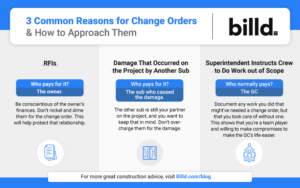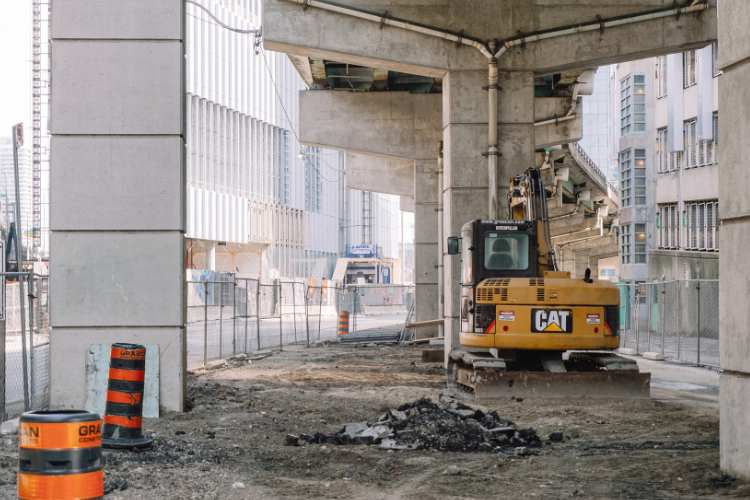Change orders are a routine aspect of construction projects. Subs are awarded contracts with clear expectations. If they’re later asked to go outside of the original scope, a change order follows. Change orders are accompanied by additional costs, which the general contractor, owner, architect, or sub may end up being responsible for.
When you’re hit with a change order, multiple factors affect how you should approach the situation. You can adopt different strategies based on how the change order arose, and who on the project is responsible for paying for it. If a change order is handled poorly, it can hurt relationships on the project. To that end, we’ll go over some common reasons for change orders, with strategic advice on how to approach specific scenarios.
Table of Contents
3 Common Reasons for Change Orders & How to Approach Them

RFIs
An RFI (request for information) occurs when a sub or the GC need clarification around something in the construction documents. There may be informational gaps in the plans, specs, drawings or agreements. The architect may have made a mistake, or an aspect of their design may be viable on paper, but not constructible in reality. RFIs are extremely common, with hundreds on every project, and thousands on bigger projects. So change orders that result from RFIs are equally common.
For Example: The subcontractor spots an issue that requires a switch from copper to metal framing. The sub will communicate that to the GC, and they’ll do the RFI paperwork. The architect may come on site and confirm that the sub is right. This bumps up the cost from $5/linear foot to $9/linear foot. Now, the GC and subcontractor have a contract on specs that are outdated/no longer accurate or viable. As a result, their current contract underestimates the cost, so they’ll have to amend the contract with a new estimate.
Who pays for this?
More often than not, the owner will be accountable for the increased cost in this situation, which means they’ll have to pay for the change order. That’s because a mistake was made that led to the sub underquoting their bid. In some situations, if the mistake was blatant by the architect, they, or their subconsultants may be on the hook to pay for it.
The Owner Is Paying for It: How you may want to handle this
If an RFI reveals an issue and results in a change order, the owner/architect will be held responsible for covering the costs. Because the owner/architect is paying for this, you may be able to charge a typical amount, with a target margin you’re comfortable with.
However, relationships in the construction industry are critical. Don’t read this as: “If the owner is paying for the change order, it’s okay to jack up the cost.” The last thing you want is to get branded as the sub who’s always nickel-and-diming on costly change orders. While you’ll have more wiggle room to charge a bit more if the owner is paying for it, you still want to be reasonable, and safeguard the relationship (and your reputation) first and foremost.
Damage That Occurred on the Project by Another Sub
Another common reason for change orders is when one sub damages the work of another.
For Example: Let’s say you’re a mason, and while putting in piping, the plumber damages a wall you’ve already built. Now you, as the mason, will have to go in and repair the damage that the plumber did. This results in extra work for you, and additional costs of material and labor. However, in this scenario, you won’t be responsible for paying for it, because you didn’t cause the damage.
Who pays for this?
In this case, the sub who damaged the other sub’s work will be paying for it. The architect, owner and GC aren’t responsible for the costs incurred.
Another Sub on the Job Is Paying for It: How you may want to handle this
If another sub damages your work, and it results in a change order/extra work for you, you don’t want it to become a source of conflict or tension between you both. The other sub is still your partner on the project, and you want to keep that in mind. If you overcharge on a change order from one of their mistakes, it could leave a sour taste in their mouth. You may work with them on other projects in the future, and tainting that relationship would be counterproductive, as they may overcharge on a change order on one of your mistakes next time.
Superintendent Instructs Crew to Do Work out of Scope
Miscommunications between the superintendent, foreman and crews have been known to result in change orders.
For example: A crew is in the field when the superintendent asks them to do something which – unbeknownst to them – isn’t in scope. They carry out the work because they’re simply following instructions and doing their job. As a result, the sub is paying for extra work to get done, because the foreman wasn’t on site when the instructions were given.
Who pays for this?
Once the sub is made aware they were doing work out of scope, the GC might be shocked that there are now additional costs to pay. To avoid situations like this, it needs to be established that certain requests cannot proceed without a written change order – or at the very least, some communication happening between the superintendent, sub and GC. In this case, the GC is likely paying for this.
The GC Is Paying for It: How you may want to handle this
Under some circumstances, the GC will be on the hook for funding a change order. Maintaining a good relationship with the GC is your gateway to new projects, so if this is the case, you’ll want to intentionally keep costs down since you know they’re footing the bill.
In fact, here’s a strategy that may pay off later: Document any work you did that might’ve needed a change order, but was done without one. Where the GC is concerned, that’s a $0 change order – one that you could’ve charged for, but didn’t. This shows that you don’t nickel-and-dime, you’re a team player, and you’re willing to make compromises to make the GC’s life easier. If that helps you earn a reputation as someone who’s great to work with, and helps you land more projects as a result, then it was worth the cost of knocking out small tasks without change orders.
Change orders are one of many jobsite scenarios that influence labor, costs and most importantly, relationships. So why approach them reactively, when you could approach them strategically? Take a careful look at each one to determine the best course of action. Be mindful of what could improve your reputation and help you win future business. After all, without strategy, execution is aimless.








